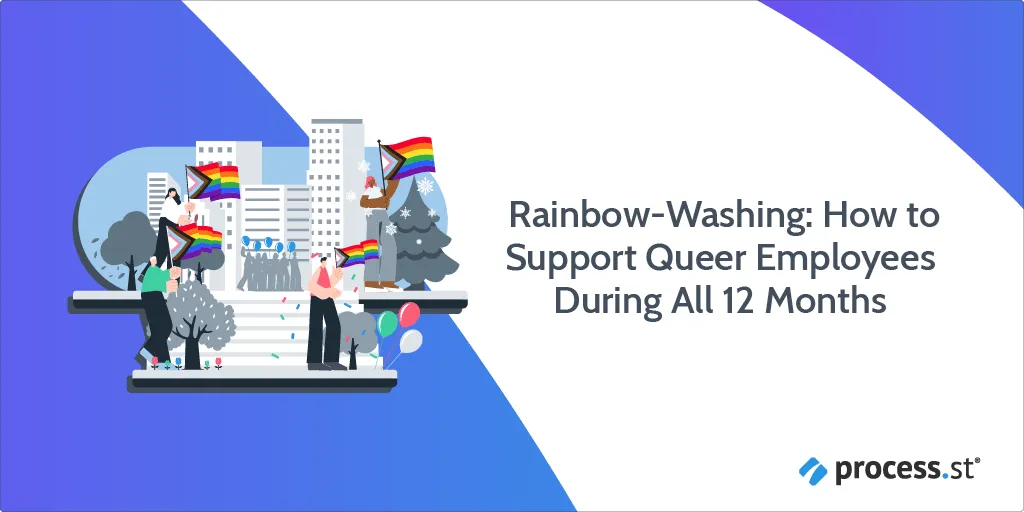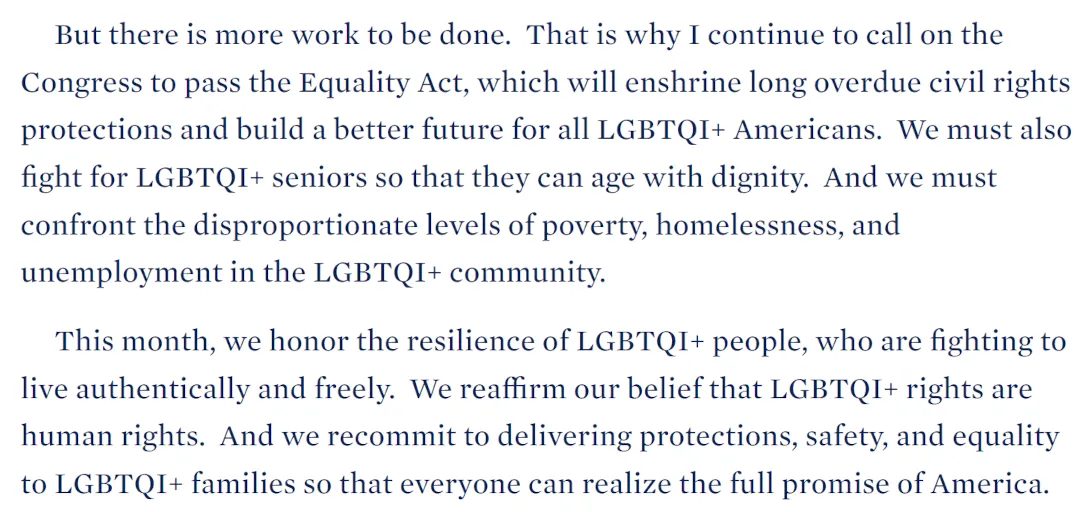Rainbow-Washing: How to Support Queer Employees During All 12 Months
Blog: The Process Street Blog

I’ll be honest: I dread all 30 days of June.
This year, I found myself looking at the Process Street LinkedIn page, now sporting a rainbow logo, and contemplating how I felt about that.
Is it rainbow-washing? What else does Process Street do to support the queer community? Why can’t I answer that question?
I don’t think it’s rainbow-washing, but I should definitely be aware of what the company I work for is doing for the queer community.
I have complicated feelings about Pride. On one hand, I do believe in the immense importance it has. Pride creates a platform for big-picture political actions as well as the more personal experience of just not being in the minority for once.
As more companies paint rainbows on their marketing materials from June 1 to June 30, it’s equally become more about commodification than community.
I see you sweating as you glance at all your packed-up Pride material in the corner. You just wanted to show your support. What does rainbow-washing even mean?
How do startups and small businesses show their allyship is genuine and not just part of a marketing campaign?
There are no simple answers to any of this, but there’s only so much room in a blog post, so I’ll give you some actionable things you can do throughout the year to keep up your support long after Pride month is over.
What is rainbow-washing?
Rainbow-washing is the capitalization of support for queer equality with the minimum effort possible.
This includes adding rainbows to logos, merchandise, ads, buildings, and pretty much anything you can think of from Skittles to Whoppers (no, seriously).
Does this mean that every company that flies the rainbow flag for Pride is guilty of rainbow-washing?
Nope, it does not. It’s actually great when companies – big corporations and small businesses – publicly support social issues – if they walk the walk.
That comes down to year-round support of the queer community in whatever way is appropriate and feasible for your organization. This might look like donating a percentage of the profits from Pride merchandise to LGBTQ organizations like the Trevor Project or making sure your work environment is a safe space for your employees.
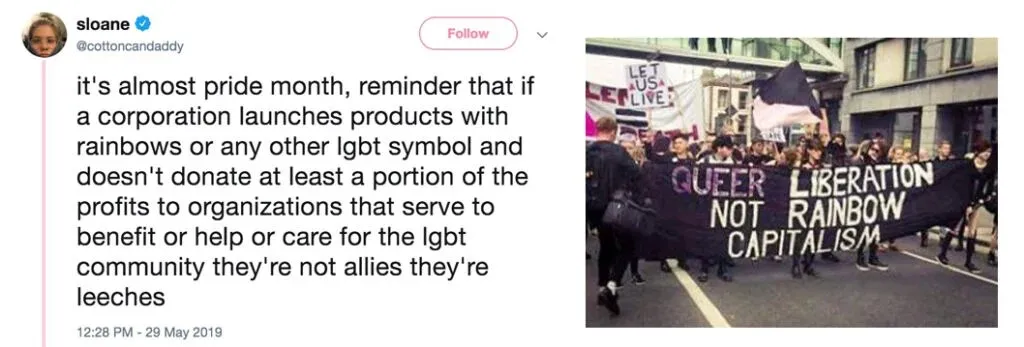
Why rainbow-washing is problematic
There’s that old saying that all publicity is good publicity.
For a long time, the queer community has followed that advice: All visibility is good visibility, right?
That’s some bullshit. Bad publicity is bad publicity and bad visibility is bad visibility.
There’s this thing economists call “pink money.” Why all things queer get branded with pink, I don’t know, but there it is.
~90% of the queer community actively boycotts anti-gay companies in favor of businesses that target “pink money.” 70% are positively influenced by queer imagery in advertising. That’s a decent demographic offering your brand loyalty and free advertising from fairly superficial gestures of support.
The most egregious result of rainbow washing is companies profiting from queer customers while donating to anti-gay politicians.
That’s essentially coercing queer people – and their allies – to fund their own discrimination through rainbow-washing.
In 2019, Judd Legum (founder of Popular Information) researched companies that publicly support LGBTQ+ communities. He found that a number of them also donated money to politicians who either didn’t support LGBTQ+ legislation or threw their weight behind anti-LGBTQ policies.
In other words, the companies Legum researched demonstrated the worst-case consequences of corporate rainbow-washing.
A few examples:
- CVS Health swapped its usual logo for a rainbow on socials. The same year, they donated $4,000 to the Texas senators trying to classify gender-affirming medical care as child abuse.
- Between 2017-2018, AT&T donated ~$28,000,000 to 193 anti-gay politiicans.
- Over the same time period, UPS donated ~$2,400,000 to 159 anti-gay politicians
- Comcast donated ~$2,000,000
- HomeDepot donated ~$1,800,000
You get the picture.

Pride needs the support of large corporations to push visibility and change, but the disingenuous ones hurt more than help.
For the average, well-intentioned consumer these brands seem like the real deal, which improves that brand’s public image, customer retention, and – ultimately – profits.
Meanwhile, the public perception of Pride shifts from political change, advocacy, and protest to consumerism, merchandise, and celebrity appearances. The purpose of Pride – remembering the anniversary of Stonewall – is not only diluted but lost entirely in washed-out rainbows.
Pride: A first-hand account
The last Pride event I went to was London 2019.
There were stunning performances, powerful speakers, really good food, and, unbelievably, it was all reasonably priced. (Read: Dirt cheap for London.)
Eventually, we headed over to one of the nearby bars jam-packed with Pride spillover. Everyone was decked out in rainbow this and that – beads, hats, fans, flags, face paint, anything that could sport a rainbow. Me, I was wearing a shirt that said, The first Pride was a riot.
The place was so crowded that the neighboring tables – an older couple and a woman, among others – essentially joined our group. Pretty typical for Pride.

Then the woman pointed at my shirt and said, “That can’t be true.”
Everyone, of course, turned to read my shirt, and in an instant, the separation between queer and straight became awkwardly palpable. As the older couple and I looked at each other, it didn’t matter who we’d arrived with; the three of us were on one side, all of our friends on the other.
Someone finally said, “It means Stonewall,” and the riot was explained as much as it could be explained by semi-drunk people to semi-drunk people in an overcrowded bar.
Meanwhile, the woman – just as decked out as everyone else in all her rainbow regalia and, I’m sure, that most of that merchandise probably came from rainbow-washing – listened in with a mixture of shock and disbelief.
It wasn’t her fault that she didn’t know the history or that – for her – Pride was a really kickass party. But I was still ready to go home.
Allyship 101: Taking pride in Pride
“The days of simply slapping a rainbow on your packaging and calling yourself ‘LGBT-friendly’ are long gone. The community demands a yearlong, enterprise-wide commitment to the LGBT community within the company and in every market the company hopes to engage.”
– Justin Nelson, president and co-founder, National LGBT Chamber of Commerce
Major corporations have the resources to design targeted merchandise, run huge campaigns, and make considerable donations to show their support. They also have an extensive platform to speak from. When a company like Disney makes a statement (or doesn’t) on a social issue, people take notice.
But it doesn’t take a grand gesture to be an ally to your queer employees. Here are five things you can do that – while they may not be as splashy as a limited edition sneaker – will improve your employees’ work experience.
Allyship 101: Action
You probably don’t have the power to implement federal legislation in order to show support for the queer community. Not many people do, as it happens, but there are plenty of other ways you can take action in the fight for equality and against rainbow-washing.
I just told you it’s not about spending money and now I’m saying you need to spend some money.
The obvious action is to donate to LGBTQ organizations.
Yes, I did just say that being an ally isn’t about spending money.
There’s a little yes and a little no in that. It doesn’t take a lot of money and it doesn’t have to be your money.
Stonewall has a variety of challenges and fundraising opportunities your company can get involved in. The Trevor Project and GLAAD also have suggestions you and your employees can participate in. Check the end of the article for more info on how and where you can lend a hand.
You can also offer volunteer time off (VTO) for your employees, allowing them to volunteer during work hours (and still get paid for it). This is a great way to let your employees know that you’re invested in the things that are important to them.
It links you to the community around you as well, which – to be brutally crass about it – is great PR for your company.
Allyship 101: Education

In my experience, most people usually aren’t intentionally homophobic; they don’t think about what they’re actually saying.
Like many minority groups, queer individuals tend to have an outward face and an inward face; that is, how you act when you’re the only queer person in the room versus your behavior when everyone in the room is queer. This creates both a language and a culture that only queer people really live in.
And this is how people end up saying dumb things with good intentions. If you don’t know what’s inappropriate or offensive to a particular group, you don’t know how to be appropriate or inoffensive.
You have to educate yourself. The key word here being you. Take initiative and find out what you don’t know. Some of your employees may be happy to clue you and their colleagues in but don’t rely on them for that.
It’s your responsibility to make sure your company is a safe and welcoming place to work for all of your employees.
(There’s a list of some good resources at the end of this post.)
Allyship 101: Healthcare
1 in 4 people has experienced LGBT discrimination by staff when accessing healthcare.
1 in 7 avoid treatment altogether for fear of discrimination.
1 in 8 receives unequal treatment from staff.
25% (62% for trans patients) face healthcare workers who fail to understand their specific health needs.

Healthcare is a big issue: Accessing the right services, but also accessing health coverage at all.
Insurance companies, for example, can deny trans-related treatment by claiming it’s a pre-existing condition. Many of the procedures vital for the health and wellbeing of trans individuals are also still considered cosmetic, and therefore not covered by insurance.
The queer community also has higher instances of drug abuse, depression, anxiety, suicidal ideation, serious mental illness, self-harm, and assault.
You can’t solve these problems yourself – and your employees may not experience any of them – but providing adequate healthcare options will provide one less barrier in terms of handling these issues.
It’s also worthwhile ensuring that your insurance program includes LGBT or LGBT-friendly doctors who are fully aware of the unique needs of their queer patients.
I can tell you from experience, that it is not at all reassuring when you’re more well-informed than your doctor.
Allyship 101: Language
Words matter.
You make judgments about people and things all the time without realizing it, solely based on the words that are used to describe them (or by them).
You’ve probably formed a judgment about me based on my preference for the word “queer” over “LGBTQ” (and variations). It might make you uncomfortable (“I don’t like that word.”), unsure (“Is it okay to say that?”), or even angry (“It’s so derogatory.”).
Regardless, you’ve made a judgment.
The importance of the language you use stretches to every part of your organization, however.
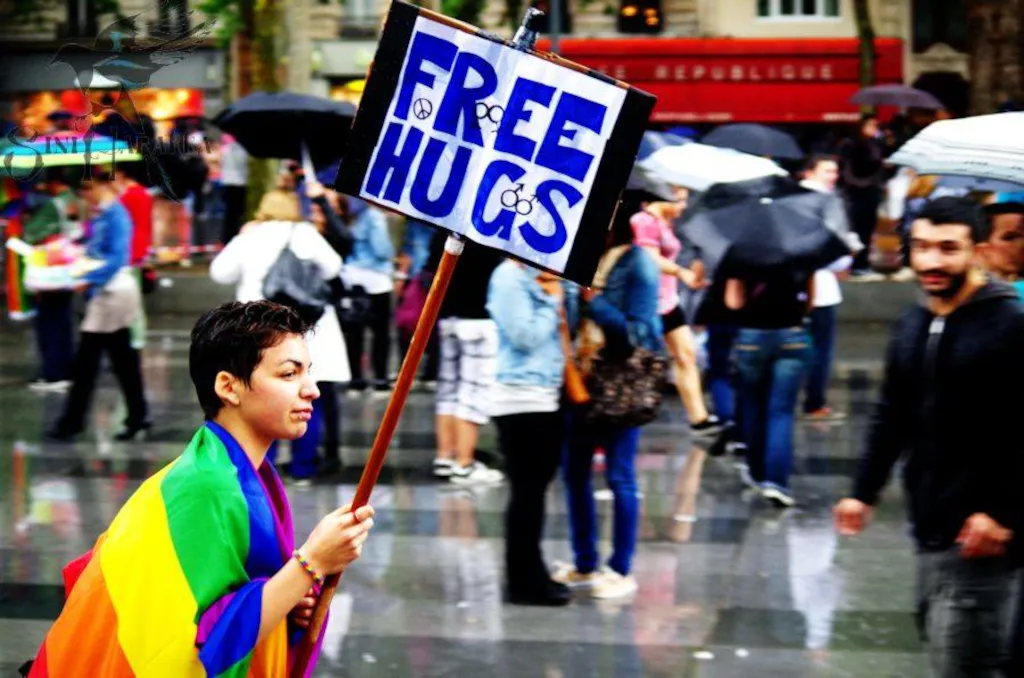
Job postings are a great way to see exactly why this matters.
In their paper, Evidence that gendered wording in job advertisements exists and sustains gender inequality, Danielle Gaucher, et al, determined that in jobs advertised with more “masculine-coded” wording (in areas not already gender coded), applicants were predominantly men.
Masculine-coded words would be things like leader, competitive, and dominant. Words we associate with feminine qualities would be supportive, committed, and dependable.
That doesn’t mean other genders aren’t capable or don’t possess those qualities; it means that on a subconscious level, we associate those qualities with a particular gender. So if you’re getting an excessive number of male applicants for your highly competitive leadership role, maybe take a second pass at the language you’re using.
Given that gendered language can have such a huge impact on the traditional binary genders, it adds another obstacle to those who identify outside the binary, as a different gender than assigned at birth, or simply don’t fit into the “typical” idea of masculine/feminine.
Queer individuals can often feel pressured to conceal their personal identities at work in order to have access to the same opportunities as their cis/heteronormative colleagues.
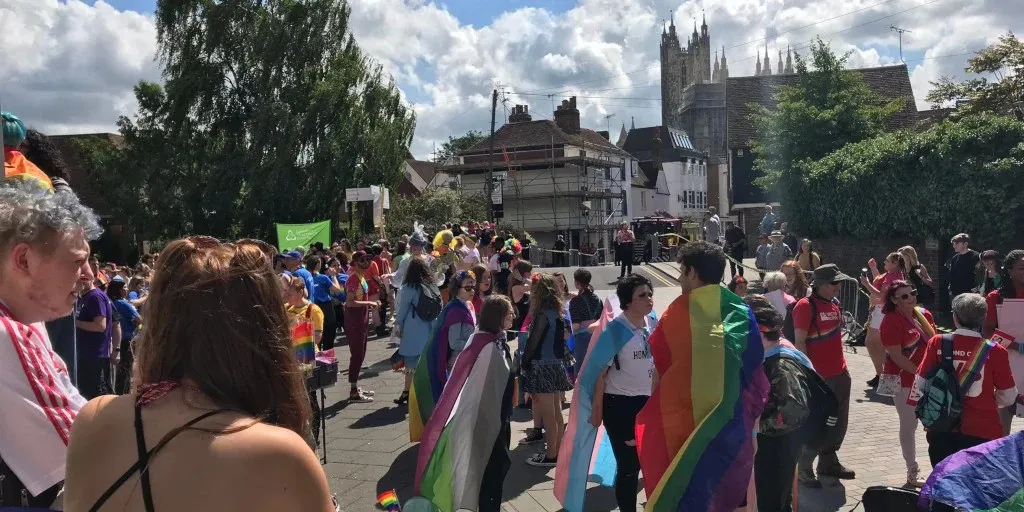
In addition to the standard “equal opportunity employer” claim on our job postings, it also says:
Confidence can sometimes hold us back from applying for a job. But we’ll let you in on a secret: there’s no such thing as a ‘perfect’ candidate. Process Street is a place where everyone can grow. So however you identify and whatever background you bring with you, please apply if this is a role that would make you excited to come into work every day.
Again, this is something that’s beneficial to queer and non-queer people alike. 83% of Gen Z (soon to be the largest portion of the workforce) prioritizes diversity and inclusion in a company.
And diversity for Gen Z isn’t just about age, race, gender, and so on; Gen Z is looking for cognitive diversity. This means inclusivity when it comes to identities, ideas, experiences, and opinions – not just the traditional definition.
Allyship 101: Resources
I’d been at Process Street for maybe a year or so before I very quietly outed myself during a team meeting by using my partner’s pronoun.
This had absolutely nothing to do with Process Street or the people who work here.
My reticence came down to a work history filled with organizations that claimed equal opportunity but weren’t. Not only workplaces, either: Schools, doctors, police, business owners, random strangers, the list really does go on.
Once you’ve been treated badly enough times, you don’t trust anyone – even the ones you trust.
One strategy to alleviate this tension in your own organization is to create an Employee Resource Group (ERG). ERGs are voluntary, employee-led groups organized by common identities or backgrounds.
These groups are formally supported by the organization and aim to offer more support to marginalized employees by creating a safe space for them to network and interact with each other.
The first ERG started in the 1960s at Xerox, organized by Black employees to discuss racial tension in the workplace. For marginalized employees, these spaces are an incredibly important resource to have.
Not only do they provide extra opportunities to network and build better business relationships, but they also provide a space where the employees can “bring their whole selves to the table.”

For individuals that are frequently told to tone down, hide, or outright change aspects of themselves, ERGs can offer some much-needed downtime.
Imagine you have to speak a foreign language all day, every day. You’re fluent in it, but at the same time, it’s often difficult to communicate what you really want to say.
Maybe you can’t roll your Rs so others presume you aren’t as skilled or knowledgeable as you actually are.
Maybe when you’re really tired or having a stressful day, it’s harder to translate from one language to another so your colleagues alienate you for not behaving the way they expect.
At the end of the day, you go home. You don’t have to translate yourself. The people there use all the same slang and colloquialisms. Some have advice on how they cope with similar situations. Some help you practice your pronunciation. That’s pretty much what an ERG does.
Employee assistance programs (EAP) are also beneficial to providing support to your employees, whether this is conflict within the office, mental health, major life changes, or substance abuse.
(LGBTQ adults are twice as likely to suffer a substance abuse disorder.
Back to the beginning
So I’m looking at Process Street’s rainbow logo on LinkedIn and trying to decide how I feel about it.
I don’t feel great about it. But I know it absolutely isn’t a case of rainbow-washing. I know these people, and I know this isn’t an attempt to look inclusive.
It just looks like an attempt to look inclusive.
I do this for a few days, a week. Inevitably – being the person that I am – I post my thoughts in our content team Slack channel.
And – being the sort of company we are – the response I get is: How can we do better?
That’s what it all comes down to. You don’t need a big budget or a big platform to support your employees beyond Pride; you just need to start the conversation.
Or create a company culture where an upstart writer is able to go to the CEO and say, Look, I don’t feel good about this. We aren’t doing it right.
Ask your employees how you can be more involved, or how you can enable them to be more involved. Look at organizations, businesses, and initiatives within your community.
Even if all you can do right now is create a safe, inclusive environment for your queer employees, that’s a pretty important contribution, too.
Further resources
Obviously, this list isn’t extensive. There are a lot of different resources out there with things to say on the topic. You’re top sources for information that you can trust are going to be the major advocacy organizations:
- Amnesty International
- American Civil Liberties Union (ACLU)
- GLAAD
- Human Rights Campaign (HRC)
- Lambda Legal
- National LGBTQ Task Force
- PFLAG
- Stonewall
You can also check out the following articles for more tips and info on supporting your queer employees:
- CIPD HR-inform: Pride Month: How to support LGBT employees at work
- CIPD: Inclusion at work: perspectives on LGBT+ working lives
- CultureAmp: Beyond rainbow washing: Supporting LGBTQ* at work and beyond
- Glassdoor: 10 Ways to Support LGBT Employees
- Forbes: Proud Of Pride Or Rainbow-Washing: How Do Retailers Step Up To The Mark?
- History: How Did the Rainbow Flag Become an LGBT Symbol?
- HRC: Understanding the Transgender Community
- Included Health: 7 Ways To Support Your LGBTQ+ Employees Beyond Pride Month
- OutBüro: 14 Ways to Support LGBT Employees
- Stonewall: Top 10 tips for LGBT inclusion in the workplace
- Wired Staff: The Problem With the ‘Rainbow-Washing’ of LGBTQ+ Pride
How do you feel about rainbow-washing during Pride: Can it be a positive act? Let’s debate it in the comments!
The post Blog first appeared on Process Street | Checklist, Workflow and SOP Software.
